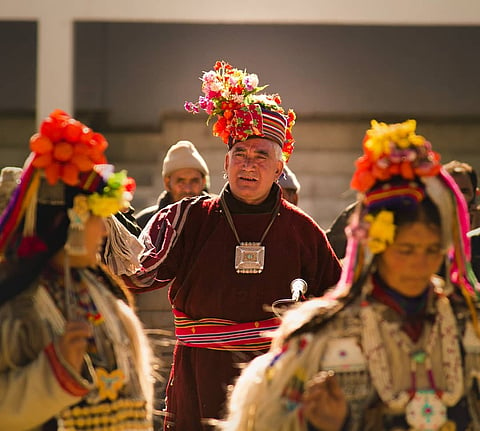
- Destinations
- Experiences
- Stay
- What's new
- Celebrating People
- Responsible Tourism
- CampaignsCampaigns
- SubscribeSubscribe
- Buy Now

Tucked away subtly in the untamed landscape of Ladakh, towered by the Himalayan peaks and enshrouded in its cold winds, there reside a people whose existence burst forth recently among curious folks as intriguing as it is enigmatic. The Brokpa tribe, living in the Aryan valley region, have piqued interest of folks ranging from tourists to anthropologists, scholars and more. It is owing to the tribe's vibrant culture, distinctive look and time-tested customs that the Brokpa people have made innumerable headlines in the recent years.
In the Batalik region of Ladakh, nestled along the banks of Indus River and in close reach to the Line of Control (LoC), the Brokpas, or Drokpas or Minaro live. It falls in the Aryan Valley and is further divided into four villages, namely, Dah, Hanu, Darchik and Garkon. Myths and fables surround the beginnings of Brokpas. According to one mainstream theory, the Brokpas are descendants of Alexander The Great's lost army from over 2,000 years ago. They are allegedly the original residents of the site and have been there even before the Tibetan migration took place. Several theories come into play about their genealogy, fuelled by a narrative of Aryan purity and the "master race." Their characteristics, nevertheless, entail fair complexion, light eyes, and pointed facial structures.
Brokpas speak in, what is identified, as Brokskat, different from the Tibetan dialects usually spoken in Ladakh. This linguistic disparity highlights their cultural distinctiveness and gives insight into their ancestry. Since Brokskat is important to understand the tribe's legacy and guarantee its transmission to future generations, efforts have been made to chronicle and preserve the same.
Many ancient cultural traditions of the Brokpa community have not changed in generations. They celebrate a number of important festivals, such as Mentog Stanmo, which commemorates the blooming of apricot blooms; and Bonana and Chhopo Supla, which is notable as a harvest celebration. The Lopa Festival is special since it invites people of all ages to participate in dance, including kids 12 years old and up. Participants are required to form groups with a 12-year age gap, for example, 12, 24, 36, and so on.
The Bonana Festival alternates between the villages of Dah and Darchik; the third year is usually not observed because the village, which is currently in Pakistan-occupied Kashmir, attends the celebrations. Prior to their separation as a result of India and Pakistan's division, these communities shared a common culture.
Locally-grown crops like barley and tough wheat, which are frequently served as tsampa or sattu (roasted flour), have historically been the foundation of the Brokpa diet. Turnips, radishes, and potatoes are further essentials. A notable beverage is Gur-Gur Cha, a brewed tea made of black tea butter, and salt. They usually don't eat dairy or poultry because of religious taboos. Mutton is frequently consumed during festivals and rituals, however meat consumption varies according to economic level.
In the past, the Brokpas practised agro-pastoralism, which combined lowland farming with high-altitude grazing. With the old divisions of labour based on gender and age becoming outdated, there has been a discernible shift in recent years towards wage labour. Additionally, the community has shifted towards formal schooling, monogamous nuclear families, private property ownership, and involvement in a militarised economy through occupations like portering and soldiering.
The Brokpa neighbourhood has seen significant changes since the introduction of tourism. Satellite receivers on rooftops and modern construction now dominate the landscape, bringing the outside world into these hitherto remote settlements. Economic benefits have been brought about by tourism, but it has also resulted in cultural dilution and difficulties maintaining customs. As they consider the loss of their cultural legacy, some Brokpas bemoan the substitution of concrete buildings for traditional cave and mud homes.
A distinctive and contentious feature of contemporary tourism in the Brokpa area is the occurrence of the strange "pregnancy tourism." On account of their faith in the "pure" Aryan heritage of the Brokpa, women from other nations, especially Germany, travel to the region specifically to conceive children with Brokpa males. Discussions concerning ethics, cultural preservation and the effects of such encounters on the social fabric of the community have been triggered by this practice.
The Brokpas maintain their distinct character in spite of the flood of contemporary influences. The language, customs and oral histories of the community are actively documented by organisations and community leaders. In order to preserve the core of Brokpa culture in the face of a fast-changing world, there is an increasing focus on teaching the next generation about their rich legacy.
